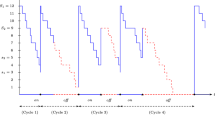Abstract
This paper models a retailer’s response to temporary manufacturer’s trade deals characterized by a time interval of random length and of uncertain duration. Uncertainty is handled primarily through the establishment of a reordering point, which serves as a trigger mechanism for new special orders. The timing at which this point is activated becomes another decision variable to be determined optimally. The model generates relatively easy-to-implement ordering policies, applicable to any probability distribution.
Similar content being viewed by others
References
Ailawadi, K. (2001).“The Retail Power-Performance Conundrum: What Have we Learned?” Journal of Retailing 77, 299–318.
Ailawadi, K. and P. Farris. (1999). “Trade Promotion: Essential to Selling Through Retailers.” Sloan Management Review 41, 83–95.
Arcelus, F.J. and G. Srinivasan. (1995). “Discount Strategies for One-time-only Sales.” IIE Transactions 27, 618–624.
Baker, R.C. (1976). “Inventory Policy for Items on Sale During Regular Replenishment.” Production and Inventory Management 17, 55–64.
Bittar, C. (1999). “Procter & Gamble Using Grease to Cut Its Detergents' Share Losses.” Brandweek 40, 46, 6–7.
Eiselt, H.A. and C.L. Sandblom. (2000). Integer Programming and Network Models. Berlin: Springer Verlag.
Friedman, P. (2002). “Cutting Waste in Trade Spending.” Progressive Grocer 81, Issue 2, 58–59.
Gonsalves, A., S. Konicki and L. Greenemeier. (2001). “In Search of the Big Picture: Supply Chains.” Information Week 858, 34–36.
Güllü, R., E. önol, and N. Erkip. (1999). “An Analysis of an Inventory System under Supply Uncertainty.” International Journal of Production Economics 59, 377–385.
Gürler, Ü. and M. Parlar. (1997). “An Inventory Problem with Two Randomly Available Suppliers.” Operations Research 45, 904–918.
Heller, W. (2002). “Promotion Pullback.” Progressive Grocer 81, Issue 4, 19.
Khang, D.B. and O. Fujiwara. (2000). “Optimality of Myopic Ordering Policies for Inventory Models with Stochastic Supply.” Operations Research 48, 181–184
Kumar, N. (1996). “The Power of Trust in Manufacturing-Retailer Relationships.” Harvard Business Review 74, 92–106.
Leech, P. (2002). “The Shaq Factor and Other Problems.” Progressive Grocer 81, Issue 11, 27–28.
Lev, B. and H.A.Weiss. (1990). “Inventory Models with Cost Changes.” Operations Research 38, 53–63.
Matlab (1999). Optimization Toolbox: User's Guide. Natick: The Math Works, Inc.
Mela, C.F., K. Jedidi and D. Bowman. (1998). “The Long Impact of Promotions on Consumer Stockpiling Behavior.” Journal of Marketing Research 35, 250–262.
Naddor, E. (1966). Inventory Systems. New York: Wiley.
Nolen, S. and C. Freeze. (2000). “Truckers Gear Up for Oil Strike.” The Globe and Mail, Saturday, September, 23.
Parlar, M. (2000). “Probabilistic Analysis of Renewal Cycles: An Application to a Non-Markovian Inventory Problem with Multiple Objectives.” Operations Research 48, 243–255.
Schwarz, L.B. (1972). “Economic Order Quantities for Products with Finite Demand Horizons.” AIIE Transactions 4, 234–236.
Tellis, G.J. (1998). Advertising and Sales Promotion Strategy. Reading: Addison-Wesley.
Tyagi, R.K. (1999). “A Characterization of Retail Response to Manufacturing Trade Deals.” Journal of Marketing Research 36, 510–516.
Wellman, D. (2000). “Frozen Food Allowances Rise.” Frozen Food Age, 48, Issue 11, 10.
Author information
Authors and Affiliations
Corresponding author
Rights and permissions
About this article
Cite this article
Arcelus, F.J., Pakkala, T.P.M. & Srinivasan, G. On the interaction between retailers inventory policies and manufacturer trade deals in response to supply-uncertainty occurrences. Ann Oper Res 143, 45–58 (2006). https://doi.org/10.1007/s10479-006-7371-4
Issue Date:
DOI: https://doi.org/10.1007/s10479-006-7371-4




